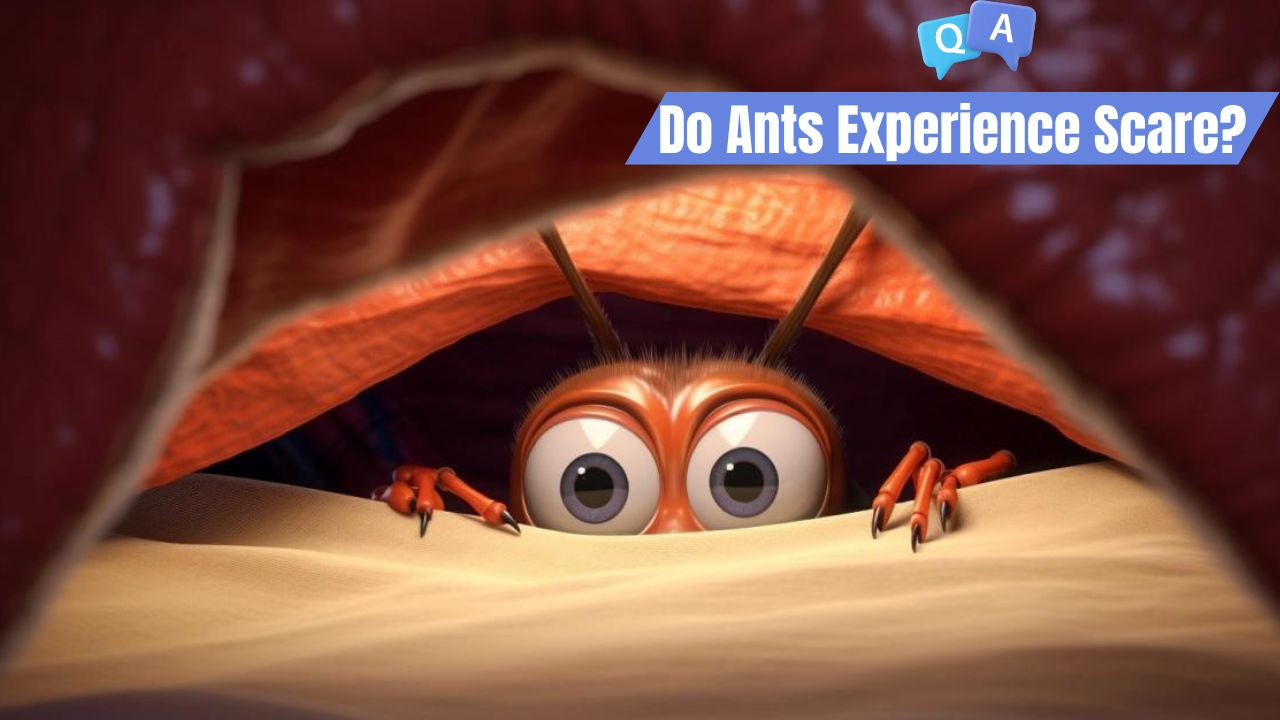TL;DR Summary
Ants do not experience fear in the human sense, but they exhibit a complex range of instinctual behaviors in response to threats that could be likened to a fear response. When faced with danger, ants show physical responses, release chemical alarm signals, and choose between flight or fight — all crucial for their survival. These behaviors impact colony behavior, influencing foraging, defense, and even long-term adaptability. Studies on ant responses to danger help us understand the ecological role of these behaviors and the broader implications of such ’emotions’ in insects. Through their reactions to threats, ants demonstrate an evolutionary sophistication in ensuring the survival and efficiency of their colonies.
In the bustling world beneath our feet, ants lead lives that are as complex as they are fascinating. I’m Professor Abigail Antenna, and it is my pleasure to illuminate the captivating subject of fear and its presence, or absence, in the life of ants. Do these industrious insects experience a form of trepidation akin to what we know as fear? And why should we, as humans, endeavor to understand the emotional palette of such tiny creatures? Let’s delve into the essence of ant behavior to uncover the threads of fear and its implications within their miniature societies.
Ants are among the most successful and widespread insects on Earth, with thousands of species thriving in ecosystems from rainforests to deserts. Their complex social structures and unparalleled teamwork have long been subjects of study and admiration. Yet, there’s an aspect of their existence that remains shrouded in mystery: their emotional experience, particularly whether ants experience a form of fear.
Ants: A Brief Overview
Ant societies are the epitome of organization and efficiency. Each ant, from the forager to the queen, has a role that benefits the colony. Their lives are a constant cycle of gathering, building, and communicating — tasks that are performed with a mechanical precision that has often led to the assumption that ants are mere automatons. But is there more to their behavior than instinct and conditioning?
Defining Fear in Ants
Fear, as we understand it in humans, is an emotional response to perceived threats, triggering a range of physiological reactions. In ants, the concept of fear isn’t associated with emotions as it is in the human psyche but is instead viewed as a survival mechanism. It manifests as an instinctual drive to react to threats that could harm the individual or the colony. This reaction, while not fear in the human sense, is a complex behavior that serves a similar purpose: to avoid danger and ensure survival.
The Relevance of Understanding Ant Emotions
Exploring the presence of fear in ants gives us a deeper understanding of the evolutionary origins of emotions. By studying how ants respond to danger, we gain insights into the development of survival strategies across species. Furthermore, understanding ant behavior in the face of threats can inform ecological management and pest control, allowing us to coexist with these vital creatures in a more informed and sustainable way.
In this exploration, we will untangle the behaviors that might be considered ‘fear’ in ants and the significance of these behaviors for the ants themselves and for the broader ecological community. Join me as we step into the world of ants and explore the nuanced dynamics of their responses to the world around them.
Ant Behavioral Responses to Threats

In the life of an ant, the presence of threats is as common as the search for food. The response to these threats is a display of remarkable adaptability and instinctual prowess, providing a window into what could be termed the ant’s version of fear. Let’s examine the array of responses ants exhibit when facing danger.
Physical Responses to Predators
When confronted with a predator, ants exhibit a series of physical responses that could be likened to a fear response in higher organisms. Some species will take on an aggressive posture, raising their bodies and opening their mandibles as a show of strength. Others may attempt to bite or sting, releasing formic acid or other toxins as a means of self-defense. Certain ant species will play dead, reducing their physical presence to avoid detection. These physical responses are instinctive actions that serve to ward off potential threats and protect the colony.
Chemical Alarm Signals
Ants communicate the presence of danger through complex chemical signals, known as alarm pheromones. When an ant detects a threat, it releases these pheromones, which can incite immediate and coordinated action within the colony. Other ants, upon detecting these chemical signals, become more alert and ready to respond to the impending danger. This chemical communication can trigger a range of behaviors, from rallying soldiers to defend the nest to signaling non-combatants to retreat to safety. The swift spread of alarm signals is a testament to the high degree of social organization within ant colonies.
Flight Versus Fight Responses
The decision between flight and fight in ants is a nuanced one, often determined by the nature and scale of the threat. When faced with minor disturbances, ants may simply scatter in a behavior known as “dispersion.” However, when the nest is under siege or a predator is threatening the queen or brood, ants may engage in a collective defense, attacking the intruder en masse. This fight response is not a reckless endeavor but a calculated act of colony preservation. Conversely, if the threat is too great, ants may opt for flight, abandoning their current location to ensure the survival of as many colony members as possible.
The behavioral repertoire of ants in the face of danger reveals a sophisticated system of threat assessment and response that is crucial for their survival. Their physical reactions, chemical signaling, and the strategic choice between flight and fight are all integral components of their response to predators and other dangers. These behaviors, while not fear in the human sense, are complex survival strategies that ensure the continuation of their species.
Neurological Basis of Fear in Ants

The neurological underpinnings of what we may interpret as fear in ants are a fascinating amalgam of instinct, hormone-driven responses, and evolutionary biology. Delving into the neural circuitry and hormonal changes that dictate an ant’s response to danger provides insight into the primal undercurrents of survival that drive these creatures.
Ant Nervous System and Stress Responses
Ants possess a relatively simple central nervous system compared to mammals, yet it is exquisitely tuned to detect and respond to environmental stressors. When an ant encounters a threat, its nervous system springs into action, triggering a series of responses that prepare the ant for either confrontation or escape. Sensory neurons transmit the presence of danger to the brain, which in turn coordinates the appropriate motor responses. This swift neural processing allows for an immediate reaction, a crucial element for an insect living in a world full of potential threats.
Hormonal Changes During Threats
Just as humans experience an adrenaline rush when faced with danger, ants also undergo hormonal changes when threats are detected. These changes may involve the release of alarm pheromones, which not only communicate danger to other colony members but also prime the ant’s own body for quick action. The ant’s endocrine system releases a cocktail of hormones that heighten alertness and mobilize energy reserves, ensuring that the ant can either fight or flee with increased vigor.
Comparative Analysis with Other Insects
When we compare ants with other insects, we find that their stress responses are both unique and universal. Many insects possess similar systems for detecting and responding to danger, yet ants exhibit particularly complex behaviors due to their social structure. For instance, the solitary praying mantis may rely more on camouflage and sudden strikes to deal with threats, while social bees, like ants, use pheromone signaling to mount a collective defense. These differing strategies highlight the role of the social context in shaping the neurological and hormonal responses to threats across insect species.
The neurological basis of fear in ants is a composite of evolved neural pathways, hormonal triggers, and social imperatives that ensure the colony’s survival. While ants do not experience fear in the human sense of experiencing emotional terror, they exhibit a sophisticated array of biologically programmed responses to danger that are essential for their individual and collective wellbeing. Understanding these mechanisms deepens our appreciation for the complexity of life forms and the universal nature of survival instincts.
The Survival Function of Fear

In the ant kingdom, the mechanisms that could be likened to fear are not merely reactions, but integral components of survival. These instinctual responses, deeply embedded within their behavior, play a crucial role in everything from foraging to the defense of their intricate communities.
Role of Fear in Foraging
For ants, foraging is the lifeline of the colony, and the fear response, or more accurately, the avoidance of danger, is pivotal in this process. Ants must be constantly vigilant to threats while they gather resources. The perception of danger, whether through alarm pheromones, vibrations, or visual cues, can cause a forager to abandon a food source, even if it’s abundant. This caution ensures that foragers do not become prey themselves and that they can return to the nest to continue supporting the colony. This balance between resource acquisition and predator avoidance is a delicate dance, where the so-called fear response plays a leading role.
Fear and Colony Defense Mechanisms
The defense of the colony is paramount, and here, the ant’s fear response is central. When a threat to the nest is detected, it triggers a cascade of defensive behaviors. Soldier ants may be mobilized, creating a barrier between the threat and the rest of the colony. Other members of the colony may begin moving larvae and the queen to safer depths within the nest. The fear response ensures that each member of the colony is prepared to play its part in the defense strategy, whether that is to fight, flee, or secure the colony’s future generations.
Fear-Induced Learning and Adaptation
Fear responses in ants can lead to learning and long-term adaptation. When an ant encounters a threat while foraging, it learns to associate specific cues with danger and will avoid them in the future. This learned avoidance is communicated to the colony, influencing future foraging strategies. Over time, these experiences can lead to behavioral changes at the colony level, with ants adapting their foraging habits, nest locations, and even their circadian rhythms to avoid predation. Thus, what begins as a simple fear response can lead to complex adaptations, both behaviorally and culturally within the colony.
The survival function of fear in ants is a multi-faceted phenomenon that is crucial to the success of the individual and the colony. It influences foraging tactics, underpins colony defense strategies, and drives the evolution of adaptive behaviors. While ants do not experience fear as humans do, the biological responses that we associate with fear are deeply ingrained in their survival strategies, demonstrating once again the profound interconnectedness of all life in the face of universal challenges like danger and survival.
Observations and Studies on Ant Fear

The study of what we analogize as ‘fear’ in ants has been a subject of entomological research for years, providing insights into how these creatures respond to perceived threats. Through carefully designed experiments and meticulous observations, scientists have sought to decode the ant’s fear response and its impact on behavior.
Experimental Approaches to Studying Ant Fear
Research into ant fear often involves creating controlled environments where ants’ reactions to various stimuli can be observed and measured. These experiments may include introducing predator cues, such as the scent of a spider, or simulating an attack on the colony. Scientists observe changes in behavior, such as increased agitation, dispersal, or aggression, as well as the release of alarm pheromones. Advances in technology have also allowed for more nuanced studies, such as monitoring changes in neural activity or hormonal fluctuations when ants are exposed to stressors, providing a window into the physiological aspect of their response.
Key Research Findings on Ant Behavior
Studies have revealed that ants can exhibit a range of behaviors when faced with a threat, from immediate flight to aggressive defense. Certain ant species have been observed to alter their foraging paths after encountering a predator, while others may increase their speed when returning to the nest with food. Experiments have also shown that ants can communicate the presence of a threat to their colony very quickly, often leading to an organized colony-wide response. These findings suggest that ants have a sophisticated mechanism for detecting and responding to danger, which can be considered akin to fear.
Implications of Fear Studies for Ant Ecology
The implications of these studies extend beyond academic interest. Understanding how ants perceive and respond to danger can have significant ecological consequences. For example, it can inform conservation strategies, particularly in areas where ant populations are critical for seed dispersal and soil aeration. It can also impact pest management practices, providing insights into how to control ant populations humanely and effectively. Furthermore, these studies can enhance our understanding of the ecosystem dynamics, as ants play a crucial role in many food chains and help maintain the balance of their habitats.
The observations and studies on ant fear contribute to a greater understanding of these complex insects and their interaction with the environment. By examining how ants respond to threats, we gain a deeper appreciation for the intricacies of their social behaviors and the evolutionary adaptations that have enabled them to become one of the most successful species on the planet.
Conclusion: The Complex Emotions of Ants

As we conclude our journey through the nuanced realm of ant responses to danger, it becomes clear that these tiny creatures exhibit a remarkable complexity in behavior that is deeply interwoven with the survival of their colonies.
Summarizing Ant Responses to Fear
Ants demonstrate an impressive range of behaviors when responding to perceived threats, from physiological changes and the release of alarm pheromones to strategic adjustments in foraging and nesting behaviors. These responses, while not ‘fear’ in the human sense of experiencing emotional distress, are sophisticated and highly adaptive reactions to environmental cues indicating danger. Ants, through their evolved neural and chemical signaling systems, exhibit a form of primal vigilance that ensures the protection and perseverance of their society.
The Impact of Fear on Ant Societies
The concept of fear, or the ant equivalent of this sensation, has profound implications for ant societies. It influences the daily decisions made by individual ants, which in turn affects the overall health and functionality of the colony. The collective response to threats can determine the success of a colony’s growth, its ability to gather resources, and even its dominance within a particular territory. Understanding these dynamics is crucial in appreciating the delicate balance of ant ecosystems and their role in broader ecological communities.
Broader Implications of Emotion in Insects
The study of fear responses in ants opens a dialogue on the broader implications of emotion in insects. It challenges our perception of insects as simple reflexive beings, instead presenting them as creatures with complex, adaptive behavioral patterns that can be likened to emotional responses. These findings encourage us to consider the inner lives of insects more deeply, recognizing them as an integral part of the rich tapestry of life that exhibits a spectrum of behaviors and interactions.
In sum, the exploration of fear in ants has revealed the intricate layers of their behavior, the survival-centric nature of their responses, and the depth of their adaptability. As researchers continue to unravel the mysteries of ant behavior, we are continually reminded of the complexity hidden within these small, yet immensely sophisticated creatures. Their ’emotions,’ so to speak, are a fundamental aspect of their success as a species and a testament to the evolutionary marvel that is life.

